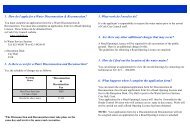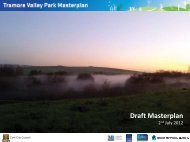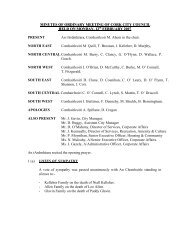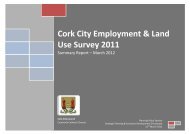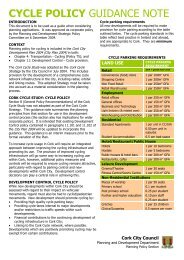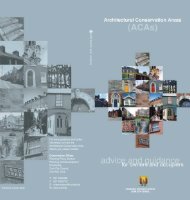Untitled - Cork City Council
Untitled - Cork City Council
Untitled - Cork City Council
You also want an ePaper? Increase the reach of your titles
YUMPU automatically turns print PDFs into web optimized ePapers that Google loves.
<strong>Cork</strong> Strategic Retail Study<br />
sites – within an easy and convenient walking distance from the primary shopping core<br />
(300-400m).<br />
2.19 Finally, they state that for all applications for large scale retail development, retail<br />
impact should be assessed.<br />
2.20 There are also policy guidelines for particular types of retail development:<br />
• Outside Greater Dublin, there is no justification for new large scale regional<br />
shopping centres;<br />
• Development plans will identify any need for new District centres, comprising up to<br />
10,000m 2 in the main towns and 20,000m 2 in Dublin;<br />
• Large foodstores will be subject to a 3,500m 2 net retail floorspace cap in Greater<br />
Dublin, and 3,000m 2 net retail floorspace elsewhere;<br />
• Discount foodstores of up to 1,500m 2 gross floorspace have a potential role in<br />
extending the choice and range of retailing;<br />
• Retail parks in the range of 8,000 to 15,000m 2 (gross) of development will generally<br />
be acceptable provided the range of goods is conditioned to the sale of bulky<br />
household goods only, i.e. carpets, furniture, white electrical goods and DIY items;<br />
• Retail warehousing units will be subject to a 6,000m 2 gross floorspace cap<br />
(including ancillary garden centre) 1 . <strong>Council</strong>s may wish to impose a minimum size<br />
condition (700m 2 ) on units in out-of-centre locations to prevent sub-division or<br />
smaller stores; and<br />
• In petrol filling stations, up to 100m 2 net retail sales area will be allowed.<br />
2.21 The aim of floorspace caps is to reduce the likelihood of local monopolies.<br />
Regional Planning Guidelines for the South West Region<br />
2.22 The Regional Planning Guidelines (RPGs) for the South West (adopted in May 2004)<br />
set a target population of 700,000 for the region by 2020 (the population at the 2002<br />
census was 580,000).<br />
2.23 In line with NSS policy, the majority of population growth is set to take place in <strong>Cork</strong><br />
<strong>City</strong> and the Metropolitan Towns, a single housing and employment market. Additional<br />
growth is envisaged at the Mallow hub, with smaller scale growth in the towns, villages<br />
and rural areas. Metropolitan <strong>Cork</strong> (<strong>Cork</strong> <strong>City</strong> <strong>Council</strong> area together with the satellite<br />
towns of Ballincollig, Blarney, Carrigaline, Carrigtwohill, Cobh, Glanmire/Riverstown,<br />
Midleton, Passage West and Tower and the strategic industrial areas and villages) is<br />
set to grow by a minimum of 65,000.<br />
<strong>Cork</strong> Area Strategic Plan (CASP) 2001-2020<br />
2.24 CASP provides a vision and strategy for the development of the <strong>Cork</strong> <strong>City</strong> sub-region<br />
up to 2020. It sets out a broad-brush rail and public transport based strategy to guide<br />
the general direction and scale of growth. The CASP strategy is currently being<br />
updated.<br />
2.25 The strategy is summarised by Figure 2.2, below. The circles identify the major growth<br />
areas, with the dark shaded sections representing existing population and the light<br />
shaded areas representing additional population.<br />
1 The threshold was amended to accommodate larger stores in IAP areas in NSS gateways in 2005<br />
Roger Tym & Partners with Simon Clear & Associates<br />
March 2008 5



